Axolotls are good pets for beginners and expert amphibian lovers alike. They have unique and exotic colors, but that’’s not the reason for their fame.
You see, they have unique regeneration skills that even today continue to baffle the scientific community. From growing an entire arm to regenerating their brain, there’s not much an Axolotl can’t do. And if that’s not awesome enough, they come packaged in a cute and lovely appearance. Just look at this beauty in the picture below!
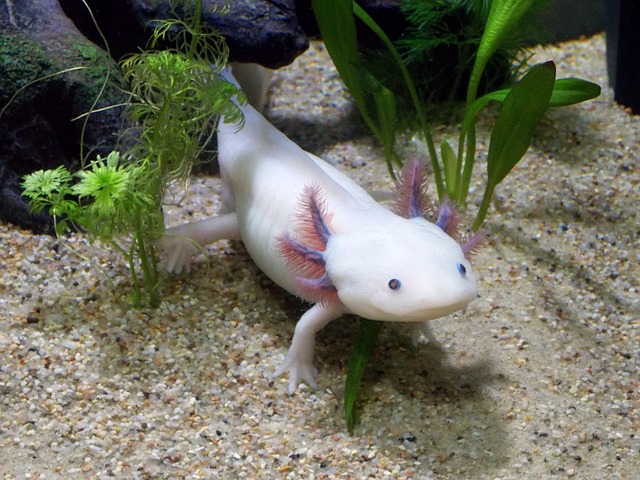
Reptile’s Crew writer Ariel Pavon will tell you more about these lovely amphibians. This article will cover all you need to know to own and care for an Axolotl, a great pet for anyone who loves a cute friend, especially if you have previous experience with amphibians.
If not, don’t worry, we’ll guide you through the process. But first…
What’s An Axolotl?
The axolotl is an amphibian salamander (Ambystoma mexicanum) named after the Aztec God of Fire and Lightning, Xolotl. Legends aside, axolotls are amphibians that didn’t evolve to walk on land and preferred to stay in the waters.
They don’t metamorph into adults like typical amphibians. Instead, they keep their larval traits in a process known as neoteny and remain in this juvenile stage for their entire lives!
Axolotls have several sets of feathery gills sprouting at the sides of their head and a mouth in what it seems like a constant upward smile.
Those are their trademark features that make axolotls great pets to have and extremely cute, but there’s something more that makes Axolotls a good pet for beginners…
Why Are Axolotls Good Pets?
The main reason is that it’s not difficult to take care of them, even for beginners.
They possess a calm temperament that soothes the soul and like to go swimming around for fun. If you look closely, you can even see them playing hide and seek around the decorations in the tank.
An axolotl is a good pet for your kid, in case you were wondering. They are great for them to bond and grow together. This playful companion can live up to 15 years, probably even longer if properly looked after. Plenty of time to make memories together.
By the way, check our article “Best reptile pets for kids” if you’re looking for the perfect friend for your child!
Axolotl Biological Facts
1. Axolotls Are Special Amphibians
Axolotls are considered special in the amphibian world because they retain the ability to breathe through their gills in adulthood.
They have wide heads and lidless eyes, traits that make them easily recognizable, and they don’t lose their external gills when maturing into an adult like other amphibians, such as frogs or toads.
They mature into adults around 18 – 27 months of life, with a length of 15 – 35 cm (6 – 16 in) and a size close to 23 cm (9 in). In rare cases, it can grow up to 30 cm or 12 inches. Not too big or small, Axolotls are good pets for anyone interested.
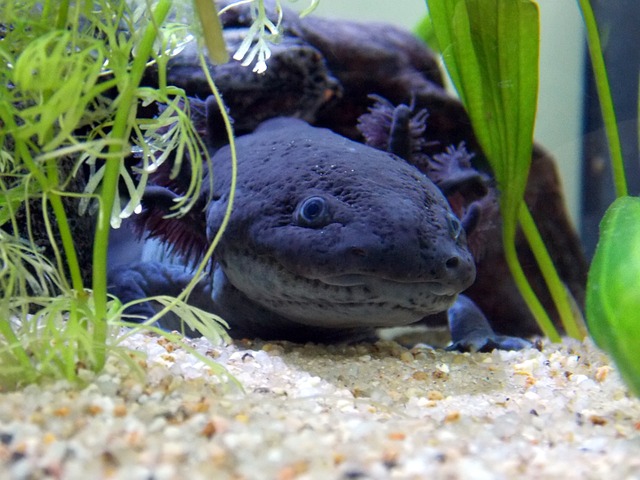
2. Axolotls Have Mind-Blowing Regenerative Capacities
These amazing fellas can regenerate limbs, gills, and parts of their brains. They don’t heal their wounds like we do, by scarring. Instead, they can regrow or regenerate entire lost appendages and vital structures like the central nervous system or tissue from the heart!
But that’s not all, their healing capacities extend to transplants too. They can accept organs from other Axolotls without rejection or side effects, using them like their own.
In short, they baffle scientists with this trait, and that’s why they research them for medical purposes.
3. Axolotl’s Have Beautiful Color Variations
This little pet is no chameleon but has the ability to somewhat change its color due to mutations during breeding.
In the wild, they’re generally brown/tan with gold speckles and an olive undertone. But the five more common mutations that breeders have managed to create, are way different.
- Leucistic: Pale pink body with black eyes.
- Golden Albino: Golden body and gold eyes.
- Xanthic: Grey body with black eyes.
- Albino: Pale pink/white body with red eyes.
- Melanoid: All black or dark blue body without gold speckling or olive tone.
Rarer colors are more expensive, but how often can you have a pet with exotic colors? Another reason why Axolotls are good pets.
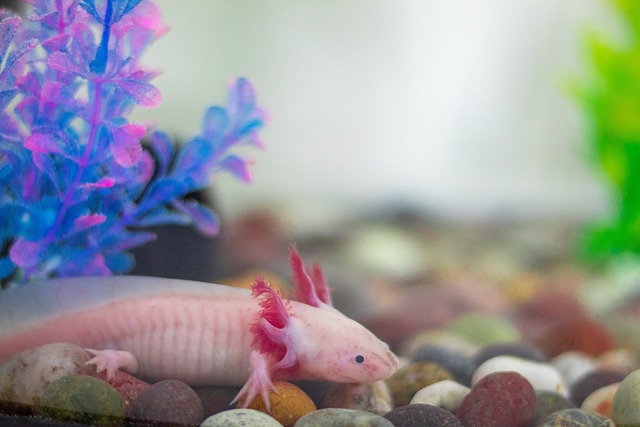
Why Forcing Axolotls to Metamorph Is Unnatural and Cruel
Other amphibians, when growing up, metamorph and lose their gills to continue their lives on land. They don’t go too far, as they need humidity to live and especially to reproduce.
To metamorph, they require a hormone produced by the thyroid gland, but Axolotls don’t naturally have it.
What’s interesting is, that although they don’t normally metamorph and don’t naturally produce the required hormone, they may metamorph under artificially induced circumstances. But we believe it’s cruel and goes against the animal’s safety and well-being.
Always remember that and just love your pet for what it is, a cute water-dwelling creature.
Knowing all this, do you still wonder: are Axolotls good pets or not?
If you think they are, let’s discuss how to set up the aquarium for your next amphibian friend.
All You Need To Know To Successfully Set Up An Axolotls Aquarium
There’s a lot of arguing in the community about whether Axolotls are easy pets to care for or not. Many claim that Axolotls are just a high-maintenance, difficult amphibian to care for. But we’re here to prove you otherwise.
With proper care and the right setup, an Axolotl can become an excellent pet for many years. But first, let’s look at its living requirements.
Proper Lighting For An Axolotl
You don’t need special lights for your shy Axolotl’s aquarium. Your normal room light is enough for them to have normal day-night cycles.
Unless other amphibians, they don’t need special UV lights or anything that resembles a sun. They enjoy chilling on the bottom of the lakes where sun rays barely reach and rarely go over to the surface.
They don’t like direct light, so it’s best to avoid setting an Axolotl’s aquarium in places where it receives direct sunlight.
For your Axolotl friend, a dim light in the room is the best. It will make it comfortable, and you’ll be able to see how he plays or his lovely appearance.
What’s The Right Temperature For Your Axolotl
Your friend doesn’t like the heat. They thrive in cool water temperatures, and they’re very sensitive to them.
The ideal recommendation is between 59 – 65 °F or 15 – 18 °C. Higher temperatures affect their immune system, making them prone to fungal infections or other diseases.
To make sure your aquarium, has the right temperature, you can use this Aquarium Chiller. It’s like a mini-sized refrigerator that connects with the aquarium and prevents the tank water from exceeding the optimum temperature.
But don’t go overboard and throw ice in there. Your Axolotl friend is not a polar bear. You must not let the water temperatures fall under 10 °C or 50 °F.
Always keep an eye on your Axolotl’s water temperature using an aquarium thermometer. Axolotls are great pets to have but can’t live without proper care and responsible handling.
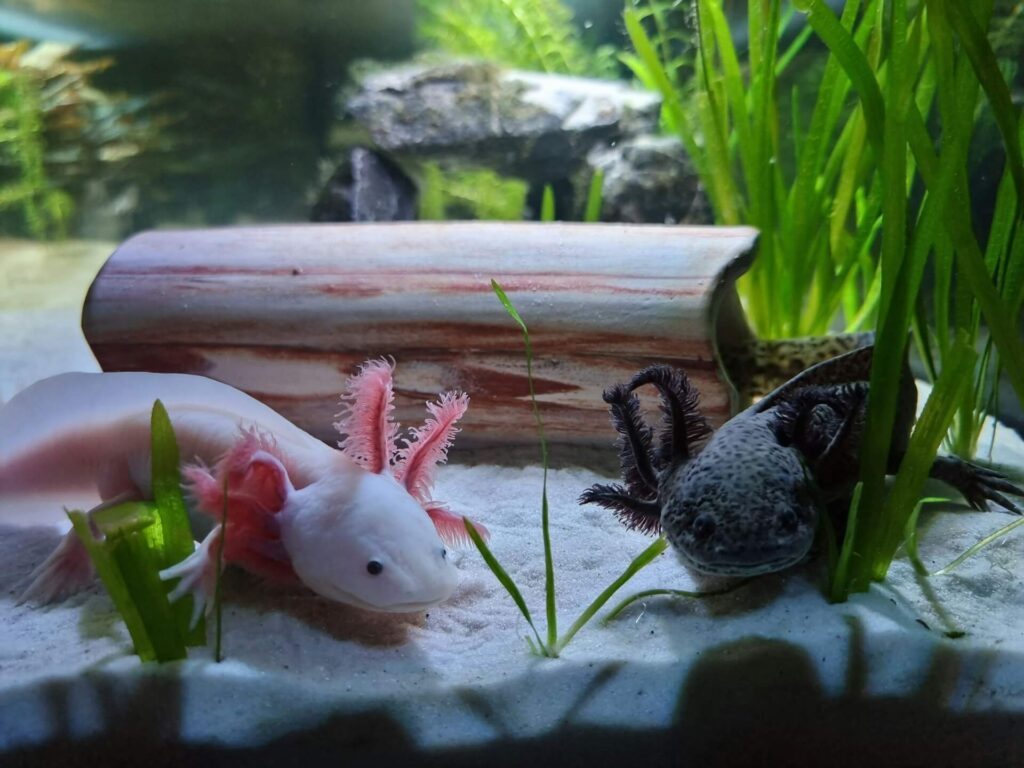
Axolotl’s Water Quality Requirements
You need an aquarium with at least 20 Gallon capacity, or 75 Liters, for a single adult. If you want to have more than one of these cuties, you need a capacity of 10 extra Gallons (37 Liters) for each extra Axolotl.
The water pH must be kept around 6.5 and 7.5 with a water conditioner that removes harmful substances like chlorine. This will make the water safe for their sensitive gills and skin.
Best Substrate For Axolotls
The bottom of the aquarium shouldn’t be gravel, because it may be easily ingested when the axolotl is feeding. Ingested gravel can lead to a digestive obstruction, which could cost your friend’s life.
A bare bottom is also a no-no. It won’t kill your Axolotl but without anything to grip under their legs, it can provoke unnecessary stress and even sore toes!
A proper aquarium should have a very fine sand substrate (ideally aquarium-safe sand) or large, smooth river rocks. They will happily roam the bottom with a comfortable grip.
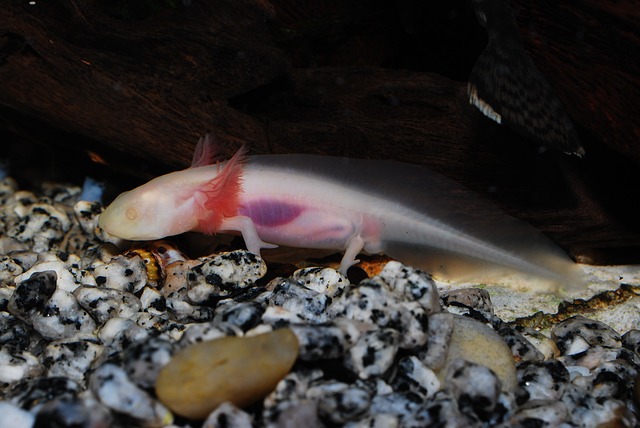
Regular Maintenance Of Your Axolotl’s Aquarium And How To Do It
They produce high waste, so a decent amount of filtration is needed. Axolotls don’t like high flows of water; hence a low-flow filter is the correct choice to avoid stress.
Perform weekly partial water changes, since changing the entire water can stress them a lot. You can use a handheld siphon or a few feet of silicone tubing for the task. Just don’t use your mouth to start the siphon. Please.
Remove any waste or uneaten food that you see. Rotting food can easily cause a lot of diseases to your axolotl and corrupt the water!
What Do Axolotls Love To Eat?
Axolotls prefer small preys as their food, such as:
- Worms.
- Mollusks.
- Insects.
- Other arthropods.
- Small fish.
They aren’t blind, but they hunt and locate their prey by smell. When an Axolotl identifies their food, they suck the prey in with powerful suction. Because they don’t have functional teeth, which means they ingest the prey whole.
Your pet axolotl doesn’t need to eat every day, so it’s best to not overfeed it, or you could cause digestive issues. Offer as much food as they want in a 5 – 10-minute period, two to three times a week. If they refuse at some point, do not keep trying to feed it.
Another good tip is not to handle their food with bare hands. Instead, use tweezers or forceps, as your hands can be potentially contaminated with bacteria.
Avoid feeding with worms for fish, as they are raised in an environment that increases the likelihood of parasites. Axolotl specially formulated pellets are great options.
If you were wondering: Are Axolotls good pets? Then all this information must have solved your doubts. But it doesn’t end here, there are several health issues you need to learn about if you’re thinking of getting one.
Health Issues To Avoid in Axolotls
Axolotl Out Of The Water? Better Not!
Have you ever seen in a movie what happens when a person floats in space without a spacesuit? Well, they die. It’s the same for your beloved pet. You can’t remove them from the water for long periods, no matter what.
To Touch Or Not To Touch
Their body is made of soft cartilage, fragile to injuries, and with sensitive skin, so petting and grabbing them is not advisable. Axolotls are good pets, but they aren’t toys to play with.
Decorate Like Martha
Their hiding spots or tank decorations shouldn’t contain any objects with sharp or textured surfaces. They have sensitive skin that can be potentially damaged by incorrect decorations.
These decorations must be big enough to avoid accidental swallowing by your Axolotl. They are like vacuum cleaners while feeding, so anything that fits will be sucked in!
If you decide to have live plants in your aquarium, always choose aquatic plants that don’t require too much light. In these cases, you can use low-powered LED lights, and provide places for your Axolotl to hide if needed.
Exposing your Axolotl pet to direct sunlight can have harmful effects like disrupting sleep cycles, stress, or even heating the aquarium’s water.
It may not look like a big deal, but raising the water’s temperature can make your Axolotl uncomfortable, to say the least, or it can damage his sensitive skin.
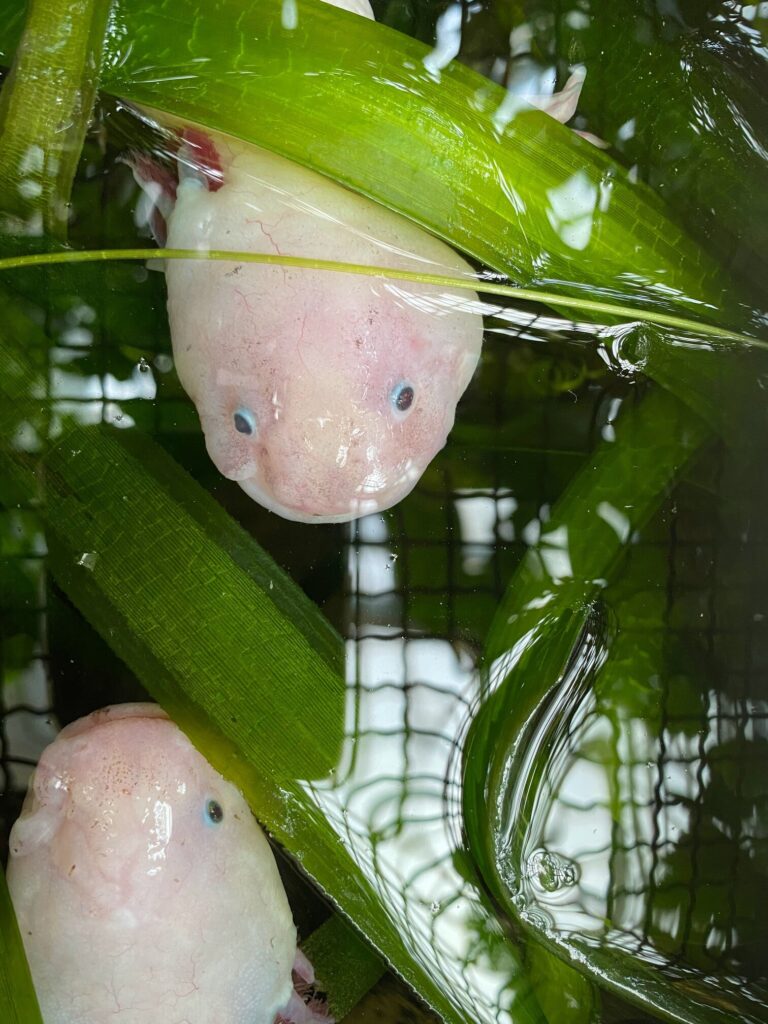
Pros And Cons Of Owning An Axolotl As A Pet
Who doesn’t love a good pro-cons list? It’s perfect to quickly understand why Axolotls are good pets! Here it goes:
Pros of Having An Axolotl
Here are our top reasons for what makes an Axolotl a great pet.
- Long lifespan: If gifted to a 10-year-old, they will grow together, always keeping him or her company at night. They live around 15 years; that’s more than even some dogs.
- Unique Biological Traits: Another fascinating reason to own an Axolotl as a pet. If scientists love to study them, you know they’re amazing creatures. You’ll have the most “X-Men” creatures on the planet.
- Isn’t Expensive: Sure, a rare breed will always cost more, but buying an Axolotl costs less than $50 – $100. The cost of buying and setting up the tank is a one-time expense. Your only ‘regular’ expense will be food, like with any other pet.
Cons Of A Pet Axolotl
- Harder-To-Find Veterinarians: If your friend gets sick, you’ll want the best medical attention to help him, right? Well, the problem is it can be hard to find veterinarians well-versed in these exotic pets, due to the rarity and unusual biology of Axolotls. A regular veterinarian may not have the knowledge to properly diagnose and treat your Axolotl.
- Delicate And Fragile: Their regeneration capabilities don’t make them immortal. They are quite vulnerable to various infections and illnesses, most of the time caused by improper care. So you must pay attention while taking care of them.
- Axolotls require a careful setup and delicate handling to avoid hurting them. It may not be the best choice for someone who doesn’t have much experience with aquatic animals. But with a little guide, anyone can properly set up an Axolotl aquarium and enjoy their company.
Axolotls are nocturnal, so most of the day they may be sleeping or avoiding bright light. Their most active hours are dawn and dusk, the twilight hours. It’s at that time that you’ll see your lovely pet more active and playing around.
Owning An Endangered Axolotl Is Legal?
This is a critically endangered species that was brought near extinction in 2020 with the urbanization in Mexico and the consequent water pollution.
Not only that, but in its natural habitat the introduction of invasive species hunted the Axolotl babies and their food.
They are illegal to own in some US states because there is public concern that they’ll be poached from the wild or escape captivity and interbreed with native salamanders.
The best course of action is to make sure Axolotls are legal where you live. Some US States require a legal permit to own them.
Also, when you buy them, do it at proper places like reputable breeders or exotic pet licensed dealers. NEVER buy an axolotl on the internet from a random stranger. It would probably come from ilegal pet trade and we don’t want to contribute to that!
FAQ
Is It Cruel To Keep Axolotls As Pets?
It’s not, as long as you buy them from legit breeders. Constant breeding and the legal pet trade have saved them from going extinct. The near-extinction state of the Axolotls is due to habitat loss and modernization, not pet trading. If their environment is no longer habitable, you can’t reintroduce the Axolotl to it.
Is It OK To Touch An Axolotl?
You may wonder, and though it’s not advisable in most circumstances, on certain occasions it might be needed. Wash your hands first to prevent passing your pet diseases like bacteria or parasites. Always be gentle, like holding a small bird. Don’t touch the gills and grab him or her around its midsection.
Can You Hold Axolotls Out Of Water?
They possess lungs, in addition to their gills, that let them breathe out of water for short periods of time. So technically, yes, you can hold an axolotl out of water. We don’t recommend it since their sensitive skin will dehydrate, losing its protective layer of mucus that fights off threats.
Are Axolotls Friendly To Humans?
You can say it that way, but in reality, the Axolotls are solitary creatures. Axolotls aren’t unfriendly, but it would be a stretch to call them sociable. Don’t expect them to behave like a puppy. Even with his keens, unless they’re mating they don’t tag along. Even so, Axolotls are good pets for anyone who loves amphibians.
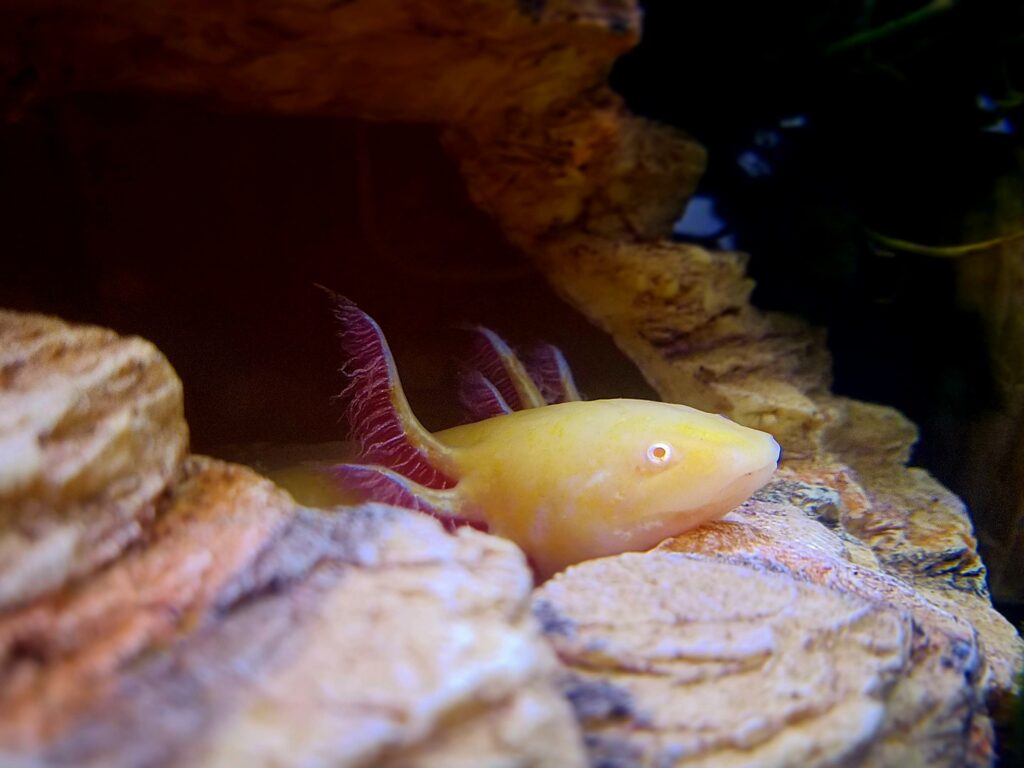
Final Words
You have read until this point, so I guess we can now truthfully answer the question: Are Axolotls Good Pets?
Yes, they are! Axolotls are great pets for your 13-year-old child who wants a friend, or anyone who wants a cute-looking and long-lasting companion to share many years together.
It may require some bit of extra work to set up everything right, but the years of loyal companionship will be worth it. You’ll have a scientific wonder (or an X-Men mutant) with you for years to come.
If you liked the article, kindly share it on your social media or send it to a friend who likes Axolotls too.
Until next time!
A total nerd since the beginnings of my life, I always had a thing for nature and found fascinating all kinds of living beings (yes, even fungus).
Reptiles became my passion and research subject in college, and I love to ramble about them to anyone interested in listening. Oh, I’m also a Copywriter!
Check the About us page to learn more about me. Keep on herping! 🙂
